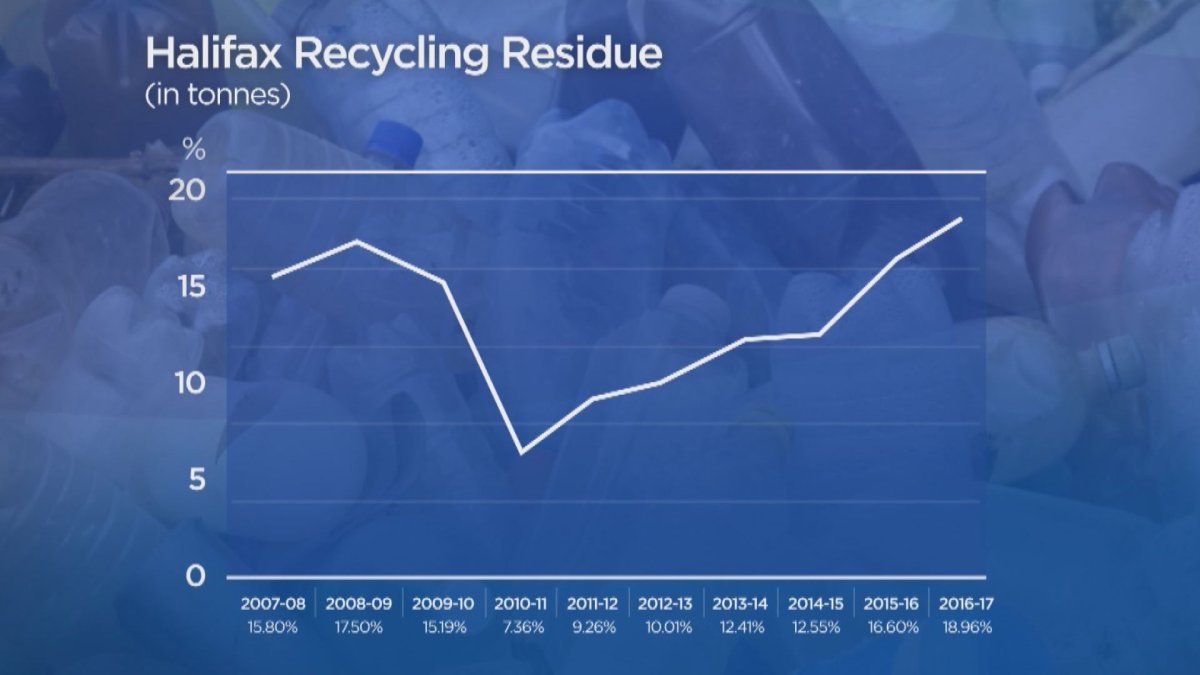Nearly one-fifth of materials collected and delivered to the Halifax Recycling Plant in the prior fiscal year ended up in a landfill, the highest rate in the past 10 years.

The data was obtained through an access to information application submitted last year.
READ MORE: Company asks Nova Scotia for permission to put plastic bags in landfill
The materials that are thrown out are classified as residue.
“We did see a slight increase in the residue rate with the implementation of clear bags, where perhaps residents weren’t a hundred per cent sure if it was recyclable or not and put it in their recyclable bag just to be on the safe side but it was actually garbage,” Matt Keliher, the municipality’s solid waste manager, said on Wednesday.
The biggest residue rate swing happened between the 2008-2009 and 2010-2011 fiscal years, dropping from 17.5 per cent to 7.36 per cent, respectively.
That 10-year low steadily increased to 18.96 per cent in the 2016-2017 fiscal year; 27,188 tonnes of materials were collected, and 5,156 tonnes of that was residue.
Reasons for the increase
Keliher said there are several factors to account for the increase.
Some small materials that are recyclable end up in the residue pile because there aren’t machines that can catch them, nor is it easy to catch by human sorters.
“So if a top of a soup can that comes into the facility, if it’s inside your can, the magnets will get it. We can grab that and put it in to be recycled, but if it’s just going on the line and the magnet doesn’t catch it, it can’t be picked up by hand because it’s going quickly across the line, and it’s very small, and it’s just hard to grab,” Keliher said.
At the plant, he showed Global News a dump truck’s worth of residue which included a pillow, Christmas lights and a laundry basket.
Another collection contained parts of a couch.
“These mainly come from large-scale commercial operations or apartment buildings and condos where they use the big blue bins,” said Keliher.
Although contractors do check what are in the bins, they don’t always spot improper items. Trucks full of improper items can be rejected.
READ MORE: Halifax dumping 75 tonnes of ‘unusable’ film plastic in another province’s landfill
Staff members can track down where large collections of improper items come from to educate those responsible.
Contamination impacts quality
Paper items that are contaminated by ketchup, spaghetti sauce and the like, have to be dumped because they would diminish the quality of the recycled paper mix.
Quality is important, especially following the outcome of China’s waste import changes, Keliher said.
Moving the residue to a landfill is an extra cost.
“We’re working actively with the operators here to make sure that we reduce that number,” Keliher said of the residue rate.
Audits are done to determine what’s ending up in the residue pile, and those piles are sometimes re-sorted.
Keliher recommends residents check online for information on what can be recycled.
- Ontario First Nation declares state of emergency amid skyrocketing benzene levels
- Singh mulls TikTok return as U.S. nears potential ban over security fears
- More financial institutes are offering crypto-services, survey shows
- Possible TikTok ban in U.S. looms after Biden signs bill, setting up legal fight





Comments